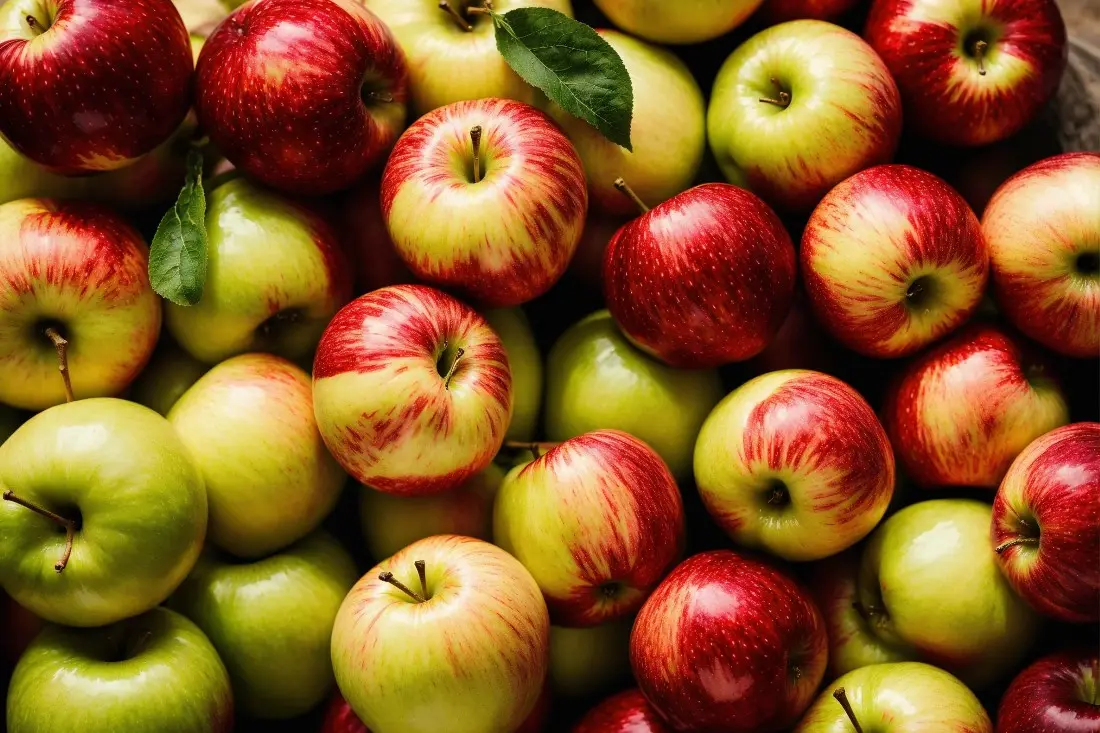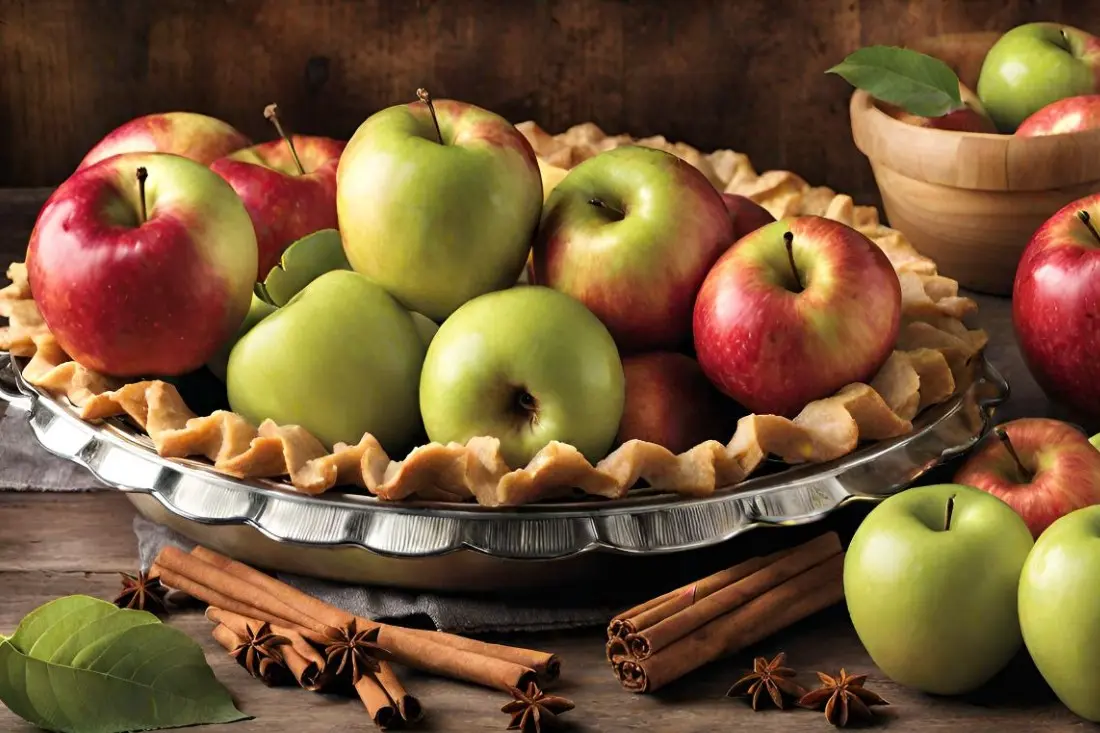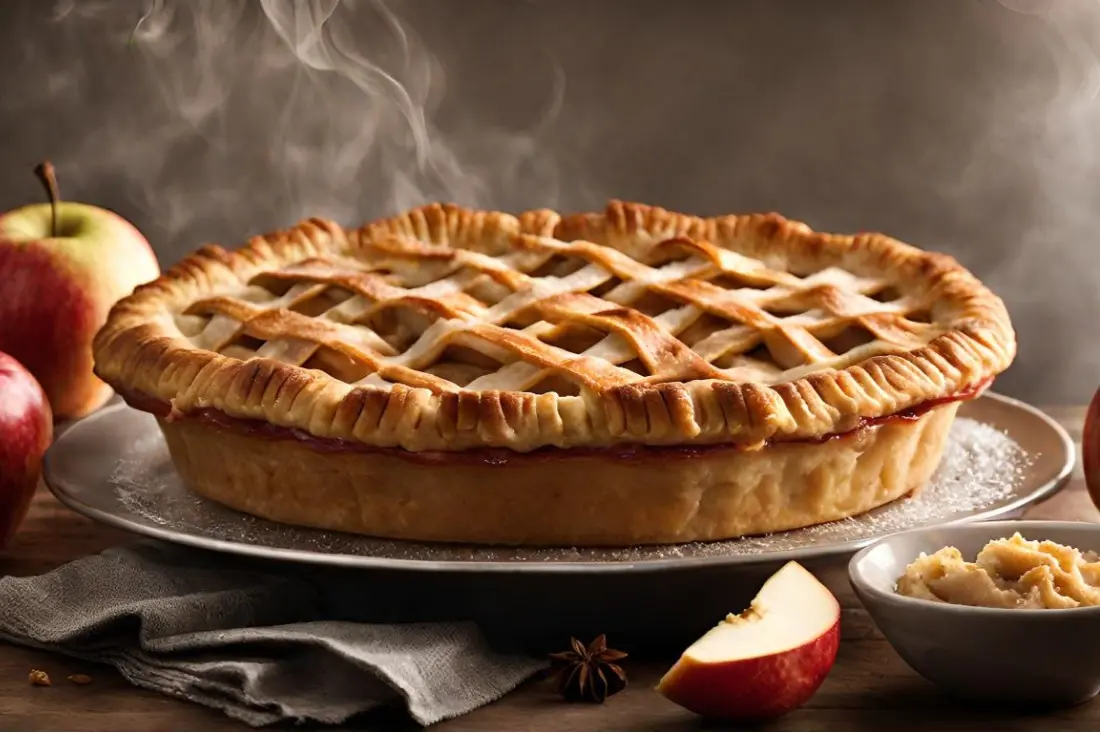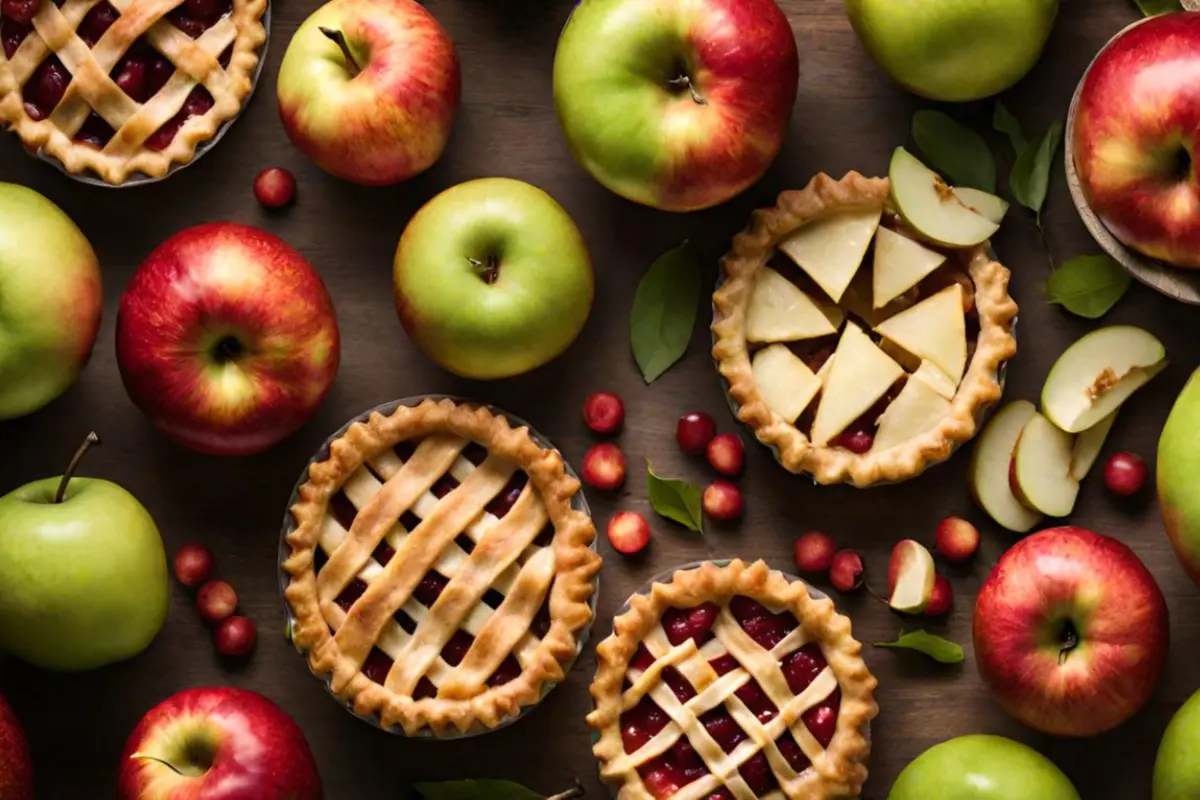Embarking on the journey of creating the perfect apple pie, a quintessential delight in the world of desserts, we delve into the pivotal choice that makes or breaks this classic treat: the selection of apples. With its roots deeply embedded in culinary tradition, apple pie isn’t just a dessert; it’s an emblem of comfort and homemade artistry. In this comprehensive guide, we’ll unravel the mystery behind choosing the best apples for your apple pie, ensuring that each slice is a harmonious blend of flavors and textures. So, let’s roll up our sleeves and get ready to explore the art of perfect apple pie making.
Introduction to Apple Pie and Apple Varieties
Introduction to the Art of Apple Pie
Apple pie, a symbol of homely comfort and culinary delight, stands as a testament to the simplicity and elegance of baking. The heart of this iconic dessert lies not just in its flaky crust or the aromatic spices, but in the very essence of its filling – the apples. The right apple can elevate your pie from good to sublime, making the difference between a forgettable dessert and an unforgettable experience.
Importance of Choosing the Right Apple
In the realm of apple pies, not all apples are created equal. The journey to a perfect apple pie begins with selecting the right type of apple. It’s a delicate balance – too tart, and your pie may pucker the lips; too sweet, and it might overshadow the nuanced flavors of cinnamon and nutmeg. The ideal apple should offer a blend of sweetness and tartness, and most importantly, it should be firm enough to hold its shape when baked. After all, no one relishes a mushy pie!
In this guide, we’ll explore various apple varieties, each with its unique flavor profile and texture, perfect for crafting that exemplary apple pie. Whether you’re a seasoned baker or a novice, understanding these nuances will ensure your apple pie is not just a dessert, but a celebration of flavors. Let’s embark on this flavorful journey!
Detailed Analysis of Top Apple Varieties for Pies

In the quest for the perfect apple pie, the choice of apple variety is pivotal. Each apple brings its unique blend of flavor, texture, and juiciness to the pie, contributing to that exquisite taste and structure we all crave in a classic apple pie. Let’s explore some of the top contenders in the apple world, ideal for your next baking adventure.
Granny Smith Apples
Granny Smith apples are a popular choice among pie bakers. Known for their vibrant green color, these apples are celebrated for their tartness and firm texture. They hold up exceptionally well under heat, ensuring that your pie retains its structure. The bright, almost citrus-like aroma of Granny Smith apples adds a refreshing note to your pie, balancing the sweetness of other ingredients.
Honeycrisp Apples
Honeycrisp apples, a favorite for many, strike a perfect balance between sweet and tart. Their crisp texture ensures that they maintain their integrity throughout the baking process, providing a nice contrast to softer apple varieties. The honeyed flavor intensifies in the oven, adding a depth of sweetness that is not overwhelming but rather, perfectly nuanced.
Braeburn Apples
Braeburn apples, with their red-orange hue, are known for their balanced flavor profile – a mix of sweet, tart, and slightly floral notes. They are juicy yet firm, softening nicely in the pie without turning into a mushy filling. The subtle spicy undertones of Braeburn apples make them a delightful choice for a pie with a complex flavor palette.
Golden Delicious Apples
The Golden Delicious apple, true to its name, is a gold standard in the apple pie realm. This bright yellow apple is crisp and sweet, and its flavor is enhanced after baking. While they may soften a bit more than Granny Smiths, the texture they bring to the pie is tender, contributing to a luscious filling.
Jonagold Apples
Jonagold apples, a hybrid of Jonathan and Golden Delicious, offer a lovely blend of tartness and sweetness. They hold up well in the oven, making them a reliable choice for pies. Their yellow-red skin adds a splash of color to the pie, and their slightly sweet yet tart flavor ensures that your pie has a full-bodied taste.
Rome Apples
Rome apples are known for their ability to withstand high temperatures, making them a good choice for pies. They have a sturdy texture and a mild apple flavor, which makes them ideal for mixing with more flavorful varieties like Honeycrisp to enhance the overall taste profile of your pie.
Northern Spy Apples
Northern Spy apples may not be the most attractive, but they are a hidden gem in pie baking. They keep their shape excellently in the oven and have a taste that complements other apple varieties beautifully. Their availability might be limited, but if you can find them, they are worth including in your apple pie.
Jazz Apples
Jazz apples, a cross between Royal Gala and Braeburn, bring a unique sweet and tangy flavor to your pie. Their teardrop note is distinctive and adds an interesting twist to the traditional apple pie flavor. Jazz apples perform well in baking, maintaining their texture and flavor.
Cortland Apples
Last but not least, Cortland apples are great for pies due to their sweet-tart flavor. They are versatile and can be used in various apple-based desserts. Their ability to maintain texture and flavor balance makes them a reliable choice for a pie that’s both delicious and visually appealing.
Each of these apple varieties brings something special to the table. Mixing and matching them can result in a pie that’s not just good, but memorable. In the next section, we’ll delve into the art of combining these varieties to create the ultimate apple pie filling. Stay tuned for tips on achieving that perfect harmony of flavors and textures!
Combining Apple Varieties for the Best Pie

Creating the ultimate apple pie filling isn’t just about choosing the best apples—it’s about combining them in a way that each variety complements the others, resulting in a filling that’s rich in flavors and textures. Here’s how you can master the mix.
Benefits of Mixing Apple Varieties
Mixing different apple varieties in your pie can transform a good pie into a great one. The combination of tart and sweet apples, along with variations in texture, adds depth and complexity to your filling. This blend ensures that each bite is a delightful surprise, with flavors that unfold gradually, tantalizing your taste buds.
Recommended Combinations and Ratios
The art of combining apples for pie filling is akin to creating a symphony where each apple plays its part. For a pie that leans towards tartness, a mix predominantly featuring Granny Smiths, complemented by a Honeycrisp and a Jonagold, works wonders. For a softer, sweeter pie, try a base of Golden Delicious apples with a touch of Braeburn. The exact ratio of apples depends on your taste, but a good rule of thumb is to have a balance between tart and sweet flavors, ensuring no single variety overpowers the others.
Tips for Balancing Flavors and Textures
Balancing flavors and textures in your apple pie filling is crucial. Here are some tips:
- Contrast Textures: Combine firmer apples like Granny Smith with softer varieties like Golden Delicious for a filling that’s both stable and tender.
- Harmonize Flavors: Pair tart apples with sweeter ones to achieve a harmonious flavor profile. This balance prevents the pie from becoming overly sweet or too tangy.
- Experiment with Ratios: Don’t be afraid to experiment with different combinations and ratios. The beauty of apple pie lies in its versatility and the endless possibilities for customization.
Common Mistakes and How to Avoid Them
Even the most experienced bakers can encounter pitfalls when making apple pie. Being aware of these common mistakes and knowing how to avoid them can be the difference between a pie that’s just okay and one that’s spectacular. Let’s delve into these common errors and learn how to sidestep them.
Choosing Overripe Apples
One of the biggest mistakes is using overripe apples. Overripe apples can make your filling too mushy and overly sweet. Always opt for apples that are firm and slightly tart. This ensures that your pie filling has the right balance of texture and flavor, holding its shape while baking.
Misjudging Apple Varieties
Choosing the wrong type of apple can significantly affect your pie. Some apples, like Red Delicious, may be great for eating but turn to mush when baked. Others may lack the necessary tartness or sweetness for a balanced pie filling. Remember, apples like Granny Smith, Honeycrisp, and Braeburn are generally safe bets for baking.
Not Pre-treating Apples
Not pre-treating apples can lead to a watery pie. Pre-treating can involve anything from tossing the slices in lemon juice to prevent browning to pre-cooking the apples to reduce their moisture content. This step is crucial in ensuring that your apple slices don’t release too much liquid during baking, which can make the crust soggy and the filling runny.
Advanced Baking Tips and Pie Recipes

Taking your apple pie from good to great involves more than just avoiding mistakes; it requires embracing advanced baking techniques and experimenting with creative variations. Let’s dive into some expert tips and innovative recipes to help you craft a truly memorable apple pie.
Pie Crust Selection and Preparation
The crust is as crucial as the filling. For a flaky and buttery crust, consider a mix of butter and shortening. The butter adds flavor, while the shortening contributes to the flakiness. Chilling the dough before rolling it out is essential, as it prevents the fat from melting too quickly, which can lead to a tough crust.
Spices and Seasonings for Apple Pie
Spices like cinnamon, nutmeg, and allspice can significantly enhance the flavor of your apple pie. The key is to use them judiciously so they complement rather than overpower the apples. A hint of lemon zest or a splash of vanilla extract can also add depth to your pie filling.
Innovative Apple Pie Recipes
Don’t be afraid to get creative with your apple pie. Consider adding unique ingredients like caramel, nuts, or a splash of bourbon for an exciting twist. You can also try different types of crusts, like a lattice top for added visual appeal or a crumb topping for extra texture.
Frequently Asked Questions About Best Apples for Apple Pie
<p>In this section, we’ll tackle some of the most frequently asked questions about making apple pie. These answers aim to clarify common queries and offer additional insights to enhance your apple pie-baking experience.
How to Prevent a Runny Apple Pie?
A runny apple pie is often caused by excess moisture in the filling. To prevent this, use a thickener like flour, cornstarch, or tapioca. Letting the cut apples sit to release some juice before baking can also help. Another effective method is pre-cooking the apple filling, which helps to evaporate excess moisture, ensuring a thicker and more stable filling.
Can I Use Different Apple Varieties in One Pie?
Absolutely! Combining different apple varieties can add depth and complexity to your pie. Mixing tart apples like Granny Smith with sweeter varieties like Honeycrisp creates a well-rounded flavor profile. Just ensure all the apples you choose hold up well during baking.
How Long Should I Let the Pie Cool Before Serving?
It’s best to let the apple pie cool for at least two to three hours before serving. This cooling period allows the filling to set and thicken, which helps in slicing the pie neatly and maintaining its structure. For the best texture and flavor, a complete cool-down is ideal.
Conclusion
As we conclude our comprehensive guide on selecting the best apples for apple pie, it’s clear that this beloved dessert is much more than just a combination of fruit and dough. It’s an art form that requires attention to detail, a touch of creativity, and a deep appreciation for the ingredients.
We’ve explored the nuances of various apple varieties, from the tartness of Granny Smith to the sweet crispness of Honeycrisp, and how combining these flavors can create a pie filling that’s rich in taste and texture. We’ve delved into the common pitfalls in apple pie making and how to avoid them, ensuring that your pie is not just delicious but also visually appealing and texturally satisfying.
The journey of making the perfect apple pie is one of experimentation and learning. Whether you’re a seasoned baker or a novice in the kitchen, the key to a great apple pie lies in understanding the characteristics of different apples and how they interact with other ingredients. It’s about balancing flavors and textures, choosing the right spices, and mastering the art of the pie crust.
As you embark on your next baking adventure, remember that each apple pie you make is an opportunity to refine your skills and experiment with new ideas. Don’t be afraid to try different apple combinations or add a unique twist to your recipe. The beauty of apple pie lies in its versatility and the joy it brings to those who share in its creation and consumption.
In closing, we hope this guide inspires you to don your apron, roll out your dough, and start slicing those apples. Here’s to creating apple pies that are not just treats for the palate but also works of art that bring warmth and happiness to any table.

